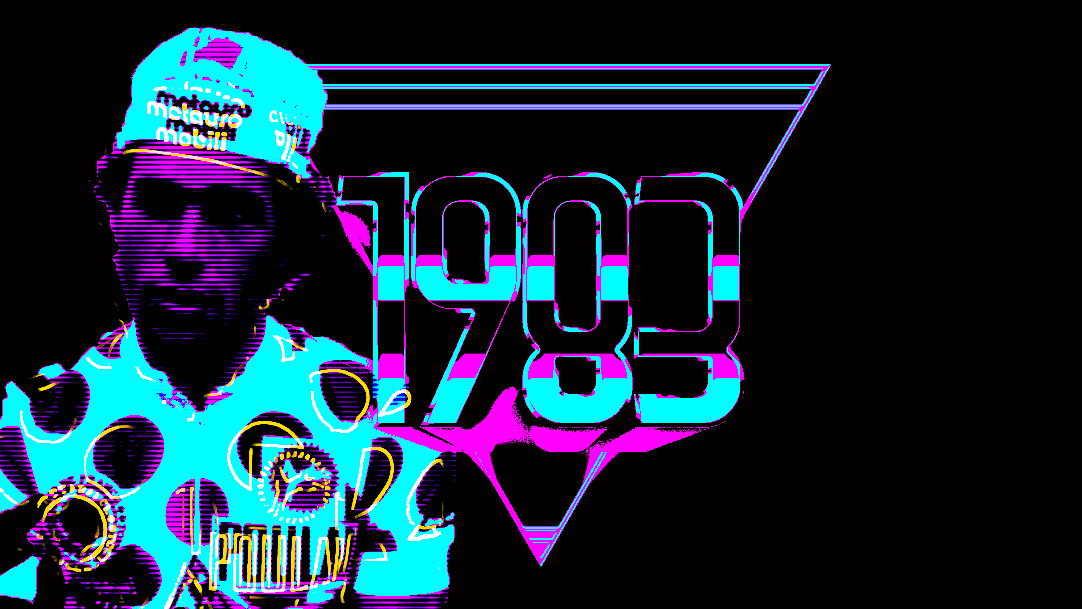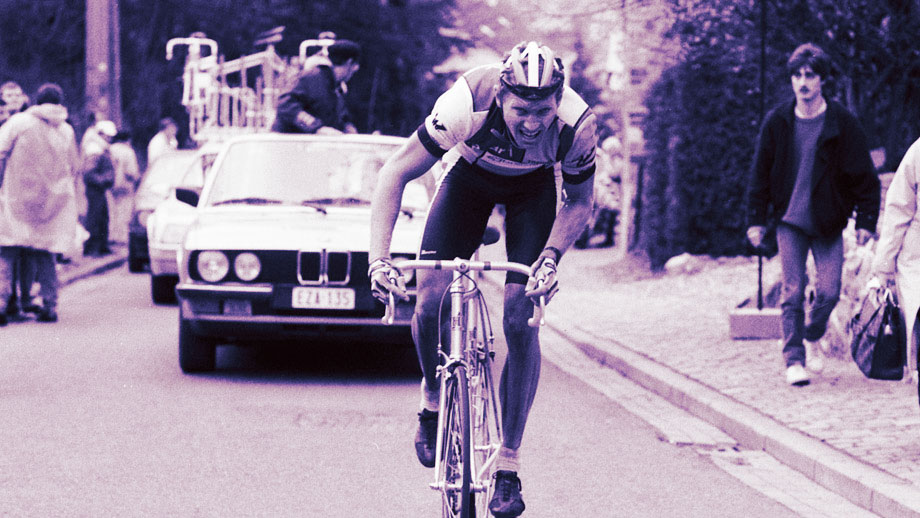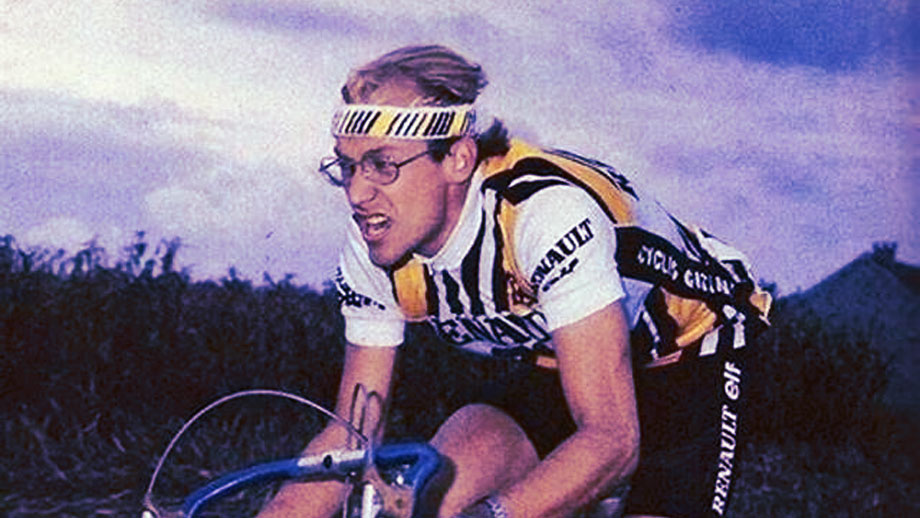
Last time, our story left off with the ASO being seduced by the concept of a Tour de France that occurs just once every four years, like the Olympics, FIFA World Cup, and UEFA European Championships. So. Did the 1983 Tour de France happen at all?
Well. Yes. Like the ASO’s half-baked plans to make the 1982 Tour a race contested by national teams, the organizers were quickly reined in by the realization that it would be an expensive experiment. Turns out that you can’t make money from TV and sponsors if you don’t run the race.
And so the 1983 Tour de France proceeded as expected. Bernard Hinault was at the start line ready to win a record-equaling fifth Tour de France, and—wait, the Badger was NOT at the start line. Huh. Then everything was to play for!
Le Tour 1983
Let’s be clear: Hinault wanted this Tour. He started the year strong as ever, winning the Fleche Wallonne and then securing his second Vuelta title. The Vuelta was one of the more exciting races an otherwise dominant Hinault had participated in thus far, and the back and forth battle between Hinault and his Spanish rivals remains one of the most spectacular editions of the race. During the race, his tendonitis returned and despite his best efforts to recover, Hinault found himself having to sit out the Tour de France.
Hinault’s directeur sportif, Cyrille Guimard, was left without a leader for the race. Laurent Fignon had impressed as Hinault’s domestique at the Vuelta and, despite concern at the rider’s young age, Guimard reluctantly agreed to take Fignon to the Tour.
The main contenders looked to be Lucien Van Impe, Joop Zoetemelk, Phil Anderson, and, perhaps, Peter Winnen.

The race started with a prologue in the eastern suburbs of Paris, then traveled north to Roubaix and proceeded anti-clockwise around the country. As with other Tours of its era, it was heavy on the time-trials, with six in total, including one prologue, one team time-trial of 100km, and one mountain time-trial to the Puy de Dome. There was also a summit finish at the Alpe d’Huez and mountainous stages into Bagneres-de-Luchon and Morzine.
Prologue to Stage Eight (1-9 July 1983)
In the absence of serious rivals for Hinault, we’d seen several young riders make their mark on the Tour so far in the 1980s. With Hinault now absent, questions arose as to whether the youth would take the opportunity to make the next step up, or whether the winner would be an elder statesman as in 1980, when Hinault withdrew due to injury. It was 37 year old Lucien Van Impe, who won the 1976 Tour and had finished second in 1981, and 36 year old Joop Zoetemelk, who won the 1980 Tour and finished second in 1982, who looked like the most likely candidates to take Hinault’s place.
The Prologue told a different story. All three Tour prologues in the 1980s had seen the same 1-2, and for the first time we saw a new rider take a victory. It was 21 year old Eric Vanderaerden who set the fastest time on the 5.5km route around Fontenay-sous-Bois, taking the yellow jersey ahead of track racer Bert Oosterbosch and prologue specialist Jean-Luc Vandenbroucke (yes, there’s a relation: he was Frank’s uncle).
Stage One was a flat stage, won in a sprint by Frits Pirard from the Metauromobili-Pinarello. Another new name for the Tour, and the stage turned out to be Pirard’s only major victory. Maybe this Tour was one of new opportunities, rather than of second chances. In other areas, it was business as usual: Sean Kelly was already staking a claim to the green jersey with intermediate sprints, and moved up to second place overall.
The 100km team time-trial on Stage Two was a return to normality, with the TI-Ral—wait, even they didn’t win? It was the Coop-Mercier-Mavic that took the victory, ahead of Peugeot-Shell-Michelin and J. Aernoudt-Hoonved-Marc Zeep. Coop-Mercier-Mavic riders made up the entire top ten, with Jean-Louis Gauthier taking over the race lead. His teammate Joop Zoetemelk occupied second place.

A messy Stage Three into Roubaix followed, with Rudy Matthijs winning the stage ahead of Coop-Mercier-Mavic’s Kim Andersen, Pascal Poisson and Sean Kelly making up third and fourth 2’09” later, and then a bunch led by prologue winner Eric Vanderaerden 3’40” down. Andersen, only 24, became the first Dane to wear the yellow jersey.
Stage Four from Roubaix to Le Havre saw yet another new name make an impact at the 1983 Tour. Serge Demierre won ahead of Sean Kelly to take his first and only Tour stage win in an otherwise relatively unremarkable career.
Another stage, another new winner. Dominique Gaigne had form: he’d won the Vuelta’s prologue earlier in the season, so his victory on Stage Five was not entirely out of the blue. Still, in retrospect it’s obvious that this Tour was going to be a change of pace when a lad who’d soon retire to become a builder started winning stages.
A 58km individual time-trial took place on Stage Six. Bert Oosterbosch took the win. Behind him, the ‘changing of the guard’ narrative was getting a bit heavy handed: Phil Anderson overhauled the excellent time-trialist Joop Zoetemelk to leapfrog him in the overall standings. Andersen and Anderson now occupied first and second place, with Sean Kelly in third. Surely Anderson wasn’t about to deliver Australia’s first Tour win?

Riccardo Magrini had won a Giro d’Italia stage in 1983 and added a Tour stage on Stage Seven. This was to be the final of his three professional victories… but if you’re only going to win three races, two of them might as well be Giro and Tour stages. If you recognized the name, it’s because he’s now a commentator for Eurosport.
Stage Eight saw Bert Oosterbosch take his second stage of the race, and the third of his career. Cycling didn’t see a Bert this good until Contador strolled up in his compression socks.
State of Play: Kim Andersen led the race by 25 seconds over Sean Kelly, and 34 seconds over Phil Anderson. 1980 winner Joop Zoetemelk hovered in fourth place. Sean Kelly wore the green jersey, and Gilbert Duclos-Lassalle led the mountains classification. Eric Vanderaerden led the young rider classification.
| 1 | Kim Andersen | Coop-Mercier-Mavic | 36h 17′ 12″ |
| 2 | Sean Kelly | Sem-Mavic-Reydel | + 25″ |
| 3 | Phil Anderson | Peugeot-Shell-Michelin | + 34″ |
Stages Nine to 17 (10-18 July, 1983)
Kim Andersen had led the race for six days, but he couldn’t make it seven. In what’s rapidly becoming a pattern, Philippe Chevallier took his first and only grand tour stage victory on Stage Nine. Behind him, Sean Kelly swept up the bunch sprint to consolidate his lead in the green jersey, but this third place came with an unexpected benefit: Kelly took over the yellow jersey by one second. Andersen and Anderson moved into second and third places respectively.
Finally, the mountains arrived on Stage Ten. Finishing in Bagneres-de-Luchon, the 200km stage shredded the peloton and destroyed the general classification. It was Philippa York, competing as Robert Millar, who crossed the line first, taking the first of her three Tour de France stage victories. York had impressed in the Dauphine to earn her place at the Tour, and had now made the first monumental step in what was to be a legendary career. Six seconds behind her, another future legend of the sport, Pedro Delgado, took second place. Pascal Simon rounded out the top three, and took the yellow jersey from Sean Kelly. Another young talent, Laurent Fignon, finished seventh on the stage, and moved all the way up to second overall, albeit 4’22” behind Simon.
A flat-ish Stage 11 followed, won by Regis Clere from a fragmented breakaway. It was largely uneventful for the general classification contenders, apart from Pedro Delgado, who made up more than a minute and a half on his rivals and moved into seventh place. Oh, and apart from race leader Pascal Simon, who crashed and broke his shoulder blade. Somehow this didn’t affect his lead, and he proceded on with his race.
Pascal Simon had a huge lead in the general classification, with a cast of youngsters plus Jean-René Bernaudeau and Joop Zoetemelk rounding out the top ten. So of course, it was time to reintroduce a different name. Kim Andersen won Stage 12, re-taking the yellow jersey– no, just kidding. But he did win the stage, and while it was inconsequential to his own general classification dreams, Pedro Delgado took a second place that moved him up to fifth overall. He’d gained two and a half minutes on Pascal Simon in two stages, and suddenly looked a threat.
Henk Lubberding won the transitional Stage 13, the third individual Tour de France stage victory of a career that had already seen him win the white jersey in 1978 and seven team time trials. His breakaway companions trickled across the line seven and a half minutes ahead of the peloton, to no real consequence.
Another hilly transition followed with Stage 14, won by Pierre Le Bigaut. Somewhat predictably for the 1983 Tour, this was his first and only Tour stage victory. The top ten remained the same, bar a couple of seconds gained by Phil Anderson to move him from ninth to tenth. The overall race was looking stagnant.
Stage 15 offered an opportunity to break the top ten deadlock. Running the tough 15.6 km from Clermont-Ferrand to Puy de Dôme, the mountain time-trial climbed to the 1,465m volcanic summit. Angel Arroyo was the surprise winner, coming home 13 seconds ahead of Pedro Delgado and 29 seconds ahead of Colombian José Patrocinio Jiménez. Behind, Sean Kelly finished an unexpected seventh, and Laurent Fignon tenth.
Pascal Simon continued to lead the race, but now by just 52 seconds over Fignon. A week or so after wearing the yellow jersey, Sean Kelly sat in third place, 1’29” down. The yellow jersey remained in his reach. Delgado was fourth, Arroyo fifth, and talented climber Peter Winnen in tenth.
Another transition followed on Stage 16. Stage race veteran Michel Laurent took the win, albeit after the race jury decided to relegate Henk Lubberding to second place following a dangerous maneuver that caused Laurent to crash into the race barriers during the sprint. Lubberding nevertheless moved up to seventh overall. Fignon and Kelly closed the gap on Simon to 40″ and 1’21” respectively.
And so to the big one. The Alpe d’Huez. Stage 17 was a 223.5km route starting in La Tour-du-Pin and finishing atop the legendary Alpe d’Huez.
We’ve included the video. Everything happens in the first 25 minutes or so. But the short story is that Peter Winnen, winner here in 1981, escaped with Jean-René Bernaudeau on the ascent. They lasted all the way to the finish line, where they sprinted for the stage win. Peter Winnen was victorious, meaning Dutch riders had won six of the Tour’s nine ascents of the Alpe.
Pascal Simon’s tenuous grip on his race lead was expected to slip here, and it did, but not in the way the fans anticipated. His broken shoulder blade proved too much, and he withdrew from the race. Fignon crossed the line in fifth place, the best of the rest, 2’07” behind Winnen and Bernaudeau. He’d earned the yellow jersey, rather than merely inheriting it. Delgado moved into second place, Bernaudeau into third, and Winnen into fourth.

State of Play: The Alpe d’Huez had shaken up the race, and Laurent Fignon and Lucien Van Impe were the clear winners: they’d claimed control of the yellow and polka dot jerseys respectively, and now had just five days left to consolidate their late leads. Meanwhile, a rampant Sean Kelly was cruising in the green jersey competition, which looked securely on his shoulders, and was also sitting in fifth overall. In the general classification, Fignon led Pedro Delgado by 1’08” and Jean-René Bernaudeau by 2’33”. The race was far from over.
| 1 | Laurent Fignon | Renault-Elf-Gitane | 82h 27′ 28″ |
| 2 | Pedro Delgado | Reynolds | + 1′ 08″ |
| 3 | Jean-René Bernaudeau | Wolber | + 2′ 33″ |
Rest Day (19 July 1983)
There was just one rest day in the 1983 Tour de France. But we’re still including two songs. Crack open a Kronenbourg because you’re going to be here for eight more minutes.
Five Stages to Fignon’s First (20-24 July, 1983)
If Fignon could endure five days of attacks, he’d win the Tour aged just 22. It was a baptism of fire for the young race leader though: Stage 18 was a tough 247km through the mountains from Bourg-d’Oisans to Morzine. Not only did he weather the storm, he actually extended his lead over Bernaudeau. Unfortunately, the peloton was packed with talent and difficult to control. Angel Arroyo put 3’31” into Fignon, moving up to fifth place, while Robert Alban climbed from seventh to fourth. Fignon had held off his closest rivals, but opened the door to others. Only Delgado lost his grip on the race, entirely dropping out of the top ten. Jacques Michaud won the stage… his first and only Tour de France stage victory of his career.
Love mountain time-trials? We do too. And so did the ASO in 1983. Stage 19 was the race’s second mountain time-trial, this time from Morzine to Avoriaz for a 15km that would unsettle the general classification once more. Fignon, this time, could only manage tenth place, losing time to Winnen, Arroyo, and stage winner Lucien Van Impe. A young Stephen Roche took second place on the day.
Finally, some respite for Fignon arrived on Stage 20. Philippe Leleu got his, you guessed it, first and only career Tour stage win with an astounding solo victory almost ten minutes ahead of the peloton. Fignon marginally extended his race lead. There was just one more stage left, and Fignon had almost three minutes over Peter Winnen in second place. Unless he rode a terrible final time-trial, he’d win the Tour. But Fignon would never ride a terrible final time-trial, right?

Right. Well, right in 1983. A second time-trial in two days, at the end of a brutal Tour, as a 22 year old who never expected to ride, suddenly dealing with the pressure of leading the race? That was nothing for Fignon. He won by 35 seconds ahead of Arroyo, and 37 ahead of Peter Winnen. Arroyo leapfrogged Winnen and Van Impe to move up to second place.
And so to the Champs Elysees. Gilbert Glaus won with, all together now, his first and only career Tour stage victory. Fignon crossed the finish line and became the youngest Tour winner since 1933. Had his team leader, Bernard Hinault, been present, he would’ve not only missed out on the opportunity to win, but wouldn’t have ridden the race at all.
Maybe there wasn’t going to be room for Hinault and Fignon on the same team…
Final Results
General Classification
Points Classification
Mountains Classification
| 1 | Lucien Van Impe | Metauro Mobili–Pinarello | 272 |
|---|---|---|---|
| 2 | José Patrocinio Jiménez | Varta–Colombia | 195 |
| 3 | Robert Millar | Peugeot–Shell–Michelin | 157 |
Young Riders Classification
We don’t normally include this, but look at these names…


